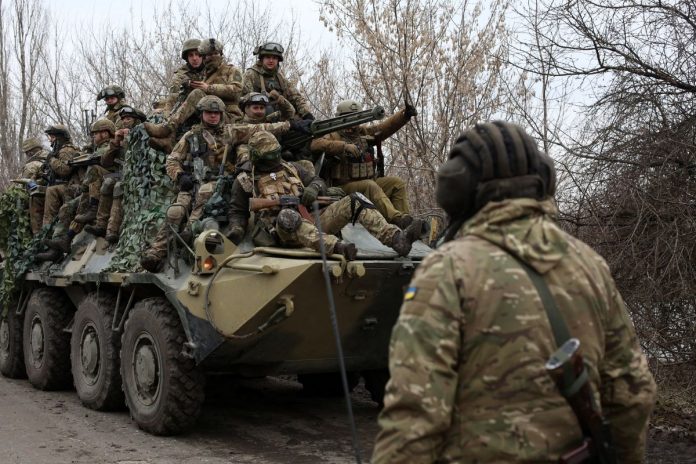On February 24, 2022, Russian President Vladimir Putin initiated a military operation in Ukraine, with blasts heard across the nation and the country’s foreign minister alerting of a “full-scale invasion.”
Mr. Putin’s new steps came only days after he ripped up a peace pact and sent soldiers into two rebel-held eastern districts to “maintain peace.”
Russia has launched an attack on Ukraine, perhaps igniting a European war over Russia’s demands to stop NATO’s eastward expansion. Russia has placed at least 200,000 troops along Ukraine’s borders recently, raising worries that this is the start of a new invasion. What happens next might put Europe’s whole security apparatus in jeopardy.
The Conflict’s Beginnings
While animosity between Russia and Ukraine, a former Soviet republic, has existed for some years, the situation began to spiral out of control at the beginning of 2021. Ukrainian President Volodymyr Zelenskyy pushed US President Joe Biden to allow Ukraine to enter NATO in January of last year.
This infuriated Russia, which began sending soldiers to the Ukrainian border for “training exercises” in the spring of last year and extended their presence during the autumn. By December, the US had begun to hype up the deployment of Russian forces, and President Biden had threatened Russia with heavy punishment if it attacked Ukraine.
Russia has requested that the West provide a legally binding commitment that NATO would not conduct military operations in eastern Europe or Ukraine. Vladimir Putin thinks Ukraine is a Western puppet and was never a real state in the first place.
This is not the first time that conflicts between Russia and Ukraine have erupted. Russia invaded Ukraine in 2014 when insurgents supported by President Putin captured vast swaths of eastern Ukraine and have been fighting Ukraine’s army ever since. At that period, Russia had invaded Crimea.
Ukraine, as a former Soviet republic, has extensive social and cultural links with Russia, and Russian is largely spoken there, but those ties have deteriorated since Russia invaded in 2014.
Russia started an invasion after Ukraine’s pro-Russian president was deposed in early 2014. More than 14,000 people have died as a result of the battle in the east.
Russia and Ukraine have signed the Minsk peace agreement to put an end to the armed war in east Ukraine, along with the Donbas area. However, as the violence has raged on, Russia has stated that it is deploying “peacekeepers” to the area where the fighting is raging. The West sees it as a ruse used by Moscow to capture sovereign land.
The renewed conflict between Ukraine and Russia, which borders the European Union, has ramifications for the EU. As a result, the European Union, the majority of which are NATO signatories, has joined the United States in imposing penalties against Russian businesses.
Only a few weeks ago, French President Emanuel Macron traveled to Moscow to meet with President Putin to defuse tensions.
How far is Russia willing to go?
President Putin may not stop at destroying the peace treaties in the east. He has hitherto only mentioned “military-technical” options if he does not get his way, while Moscow has previously reiterated that “there is no Russian invasion.”
However, the odds of a diplomatic settlement are slim, and the West worries he may go farther. “We believe they will target Ukraine’s capital Kyiv, a city of 2.8 million innocent people,” US President Joe Biden has cautioned.
In principle, Russian soldiers might march over Ukraine from the east, north, and south, attempting to destabilize the country’s democratically elected government.
They can mobilize soldiers in Belarus, Crimea, and along Ukraine’s eastern frontiers.
However, Ukraine has beefed up its military in recent years, and Russia would confront a hostile populace. The military has summoned all reservists between the ages of 18 and 60.
The number of Russian soldiers, according to top US military officer Mark Milley, would result in a “horrible” situation with a battle in dense metropolitan areas.
Russia’s Putin has other alternatives as well, such as imposing a no-fly zone or blocking Ukrainian ports, or relocating nuclear weapons to neighboring Belarus.
He might even carry out cyber-attacks. Ukrainian government websites were taken offline in January, and two of the country’s largest banks were attacked in mid-February.
What is Putin’s goal?
Russia has warned of a “moment of truth” in its ties with NATO, emphasizing three demands.
First, it seeks a legally enforceable assurance that Nato will not expand anymore. “We must ensure that Ukraine never, ever adopts NATO,” stated Sergei Ryabkov, Ukraine’s Deputy Foreign Minister.
Mr. Putin has said that Russia has “nowhere else to go” and that “do they think we’ll just sit by?”
Russia reached an agreement in 1994 to recognize independent Ukraine’s sovereignty and independence.
However, President Putin authored a lengthy paper last year identifying Russians and Ukrainians as “one country,” and now he claims that modern Ukraine was established by Soviet Russia. He sees the Soviet Union’s demise in December 1991 as the “disintegration of historical Russia.”
President Putin has also said that if Ukraine joins Nato, the alliance may attempt to retake Crimea.
His two main requests are that Nato does not deploy “strike weapons near Russia’s borders” and that the organization withdraws forces and military equipment from member nations that joined the alliance after 1997.
That includes Eastern and Central Europe, as well as the Baltic states. In truth, Russia wants Nato to revert to the borders it had before 1997.
What is Nato’s position?
Nato is a defensive alliance that welcomes new members, and its 30 member nations are certain that this will not change.
Ukraine’s president has called for “clear, acceptable deadlines” for entering Nato, but as Germany’s chancellor has acknowledged, this will be a long time coming.
The concept that any present Nato member will renounce their membership is a non-starter.
According to President Putin, the West pledged in 1990 that Nato would not extend “even one inch to the east,” but did so nevertheless.
However, because the pledge was made to then-Soviet President Mikhail Gorbachev before the Soviet Union’s demise, it solely related to East Germany in the context of a reunified Germany.
Mr. Gorbachev subsequently stated that at the time, “the question of Nato enlargement was never addressed.”
Is there a diplomatic solution?
Not for the time being, since France and the United States have canceled meetings with Russia’s foreign minister. However, both Germany and France have stated that communication is possible.
Any final agreement would have to address both the eastward conflict and weapons control.
The US volunteered to begin discussions on restricting short- and medium-range missiles, as well as a new agreement on intercontinental missiles. Russia demanded that all US nuclear weapons be prohibited from being used outside of their sovereign borders.
Russia has expressed support for a planned “transparent system” of mutual inspections on missile facilities, with two in Russia and two in Poland and Romania.


